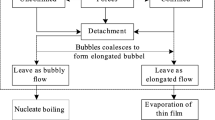Abstract
Thermal bubble formation is a fundamental process in nucleate boiling heat transfer and in many microelectromechanical thermal systems. Here, we report an experimental study of the dynamic and thermal behavior of bubbles generated at a single site, that is, a microcavity filled with alumina particles. The thermal process associated with the bubble departure from the isolated cavity, in particular, was shown to be different from that of macroscale boiling. The bubble departure diameter remains constant in a low superheat (or Jakob number) regime which is solely determined by the balance of interfacial tension and buoyancy. In addition, the bubble departure frequency increases along the bubble size as the substrate temperature rises. The further-increased frequency of bubbles emerging from the cavity causes multiple bubbles to coalesce before the preceding bubble completely detaches from the substrate, thus, leading to the decrease of apparent departure frequency with the increase of substrate temperature.
Similar content being viewed by others
References
H. K. Forster and N. Zuber, Growth of a vapor bubble in a superheated liquid, J. Appl. Phys. 25 (1954) 474–478.
C.-Y. Han and P. Griffith, The mechanism of heat transfer in nucleate boiling — Part I, Int. J. Heat Mass Transfer 8 (1965) 887–904.
B. B. Mikic, W. M. Rosehnow and P. Griffith, On bubble growth rates, Int. J. Heat Mass Transfer 13 (1970)657–666.
V. P. Carey, Liquid-Vapor Phase-Change Phenomena, Hemisphere, Washington, DC. USA (1992).
N. J. Nielsen, History of ThinkJet printhead development, Hewlett Packard J. 36 (1985) 4–10.
L. Lin, L., A. P. Pisano and A. Lee, Microbubble powered actuator, Proc. Int. Conf. Solid-state Sensors and Actuators, (1991) 1041–1044.
J.-H. Tsai and L. Lin, A thermal bubble actuated micronozzle-diffuser pump, Proc. IEEE MEMS Workshop (2001) 409–412.
L. Lin and J.-H. Tsai, Active microfluidic mixer and gas bubble filter driven by thermal bubble micropump, Sens. Actuators A 97/98 (2002) 665–671.
R. B. Maxwell, A. L. Gerhardt, M. Toner, M. L. Gray and M. A. Schmidt, A microbubble-powered bioparticle actuator, J. Microelectromech. Syst. 12 (2003) 630–640.
H. J. Lee, Y. S. Chang, Y. P. Lee, K.-H. Jeong and H.-Y. Kim Deflection of microcantilever by growing vapor bubble. Sens. Actuators A 136 (2007) 717–722.
H.-Y. Kim, H. J. Lee, Y. S. Chang and Y. P. Lee, Micro power generation based on thermal bubbles, Proc. 6 th KSME-JSME Thermal and Fluids Engineering Conference, (2005) FK 05.
L. Lin, A. P. Pisano and V. P. Carey, Thermal bubble formation on polysilicon micro resistors, J. Heat Transfer 120 (1998) 735–742.
C. T. Avedisian, W. S. Osborne, F. D. McLeod and C. M. Curley, Measuring bubble nucleation temperature on the surface of a rapidly heated thermal ink-jet heater immersed in a pool of water, Proc. R. Soc. Lond. A 455 (1999) 3875–3899.
H.-Y. Kim, K.-H. Jeong, S. Ko, H. J. Lee, Y. P. Lee and Y. S. Chang, Life of thermal bubble on platinum microheater, J. Appl. Phys. 102 (2007) 034903.
R. Siegel and E. G. Keshock, Effects of reduced gravity on nucleate boiling bubble dynamics in saturated water, AIChE J. 10 (1964) 509–517.
G. Son, V. K. Dhir and N. Ramanujapu, Dynamics and heat transfer associated with a single bubble during nucleate boiling on a horizontal surface. J. Heat Transfer 121 (1999) 623–631.
K. N. Rainey, K.N, S. M. You and S. Lee, Effect of pressure, subcooling and dissolved gas on pool boiling heat transfer from microporous, square, pin-finned surfaces in FC-72, Int. J. Heat Mass Transfer 46 (2003) 23–35.
Y. Qi and J. F. Klausner, Heterogeneous nucleation with artificial cavities. Proc. ASME Summer Heat Transfer Conf. (2005).
R. Cole, Bubble frequencies and departure volumes at subatmospheric pressures. AIChE J. 13 (1967) 779–783.
H. J. Ivey, Relationships between bubble frequency, departure diameter and rise velocity in nucleate boiling, Int. J. Heat Mass Transfer 10 (1967) 1023–1040.
P. W. McFadden and P. Grassman, The relation between bubble frequency and diameter during pool boiling, Int. J. Heat Mass Transfer 5 (1962) 169–173.
T. H. K. Frederking and D. J. Daniels, The relation between bubble diameter and frequency of removal from a sphere during film boiling, J. Heat Transfer 88 (1966) 87–93.
Author information
Authors and Affiliations
Corresponding author
Additional information
This paper was recommended for publication in revised form by Associate Editor Dongsik Kim
Young Soo Chang received his B.S., M.S., and Ph.D. degrees from Seoul National University in 1991, 1993, and 1997, respectively. Dr. Chang is currently a principal research scientist at Korea Institute of Science and Technology in Seoul, Korea. His research interests include boiling heat transfer and refrigeration.
Kwang-Hun Jeong received his B.S. degree from Pusan National University in 2005 and his M.S. degree from Seoul National University in 2007. He currently works as an engineer in Doosan Heavy Industry.
Heon Ju Lee received his B.S. degree from Korea University in 2001 and his M.S. degree from Texas A & M University in 2003. He is currently on leave from his job at the Korea Institute of Science and Technology in Seoul, and is doing his Ph.D. program at MIT. His research interests are design and fabrication of MEMS.
Ho-Young Kim received his B.S. degree from Seoul National University in 1994, and his M.S. and Ph.D. degrees from MIT in 1996 and 1999, respectively. He is currently an associate professor of Mechanical Engineering in Seoul National University, Seoul, Korea. His research interests include microscale and biological fluid mechanics.
Rights and permissions
About this article
Cite this article
Chang, Y.S., Jeong, KH., Lee, H.J. et al. Behavior of thermal bubbles formed from a single nucleation site. J Mech Sci Technol 24, 415–420 (2010). https://doi.org/10.1007/s12206-009-1112-y
Received:
Revised:
Accepted:
Published:
Issue Date:
DOI: https://doi.org/10.1007/s12206-009-1112-y




